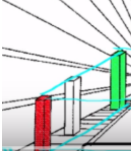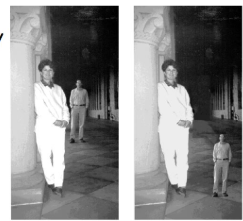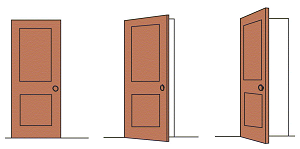sensation: perception, and 5 senses
1/39
Earn XP
Name | Mastery | Learn | Test | Matching | Spaced |
|---|
No study sessions yet.
40 Terms
what are visual cues?
allows us to perceptually organize by taking into account the following cues:
depth, form, motion, constancy
binocular cues
due to our two eyes, giving us a sense of depth.
include retinal disparity and convergence.
retinal disparity
binocular cue
eyes are ~2.5 inches apart which allows humans to get slightly different views of objects of world around, allows for sense of depth.
convergence
binocular cue
gives a sense of depth based on how much eyeballs are turned.
things far away= relaxed muscles of eyes
things close= contracted muscles of eyes
monocular cues
due to one eye
sense of form, motion, and constancy
Relative size
sense of form
monocular cue
the closer an object is, the bigger it seems to be

interposition/overlap
sense of form
monocular cue
perception that one object is in front of another. object that is in the front is closer.
relative height
sense of form
monocular cue
things higher are perceived to be farther away than those that are lower.

shading and contour
sense of form
monocular cue
using light and shadows to perceive form depth/contours – crater/mountain.

Motion parallax
sense of motion
monocular cue
“relative motion” Things farther away move slower, closer moves faster.
ex) mountains in background move slow when u driving
constancy
monoculuar cue of constancy
Our perception of object doesn’t change even if the image cast on the retina is different. Different types of constancy include size constancy, shape constancy, color constancy.
size constancy
One that appears larger because its closer, we still think it is the same size.

shape constancy
a changing shape still maintains the same shape perception.
ex) A door opening means the shape is changing. But we still believe the door a rectangle

color constancy
despite changes in lighting which change the image color falling on our retina, we understand (perceive) that the object is the same color.

sensory adaptation
Our senses are adaptable and they can change their sensitivity to
stimuli.
hearing adaptation
inner ear muscle: higher noise = muscle contract (this dampens vibrations in inner ear, protects ear drum.)
Takes a few seconds to kick in! So does not work for immediate noises like a gun shot, but it works for being at a rock concert for an entire afternoon
touch adaptation
temperature receptors desensitized over time.
ex) pool doesnt feel cold after a while
smell adaptation
desensitized receptors in your nose to molecule sensory information over time.
proprioception
the sense of the position of the body in space i.e. “sense of balance/where you are in space.”
can adapt. brain would accomodate it proprioception was skewed
sight adaptation
down regulation or up regulation to light intensity.
Down regulation: light adaptation. When it is bright out, pupils constrict (less light enters back of eye), and the desensitization of rods and cones become desensitized to light)
Up regulation: dark regulation. Pupils dilate-, rods and cones start synthesizing light sensitive molecules
just noticeable difference (JND)
The threshold at which you’re able to notice a change in any sensation
Weber’s law
ΔI (JND) / I (initial intensity) = k (constant)
predicts a linear relationship
absolute threshold of sensation
minimum intensity of stimulus needed to detect a particular stimulus 50% of the time.
factors that can influence absolute threshold of sensation
At low levels of stimulus, some subjects can detect and some can’t. Also there are differences in an individual.
Expectations – ex. Are you expecting a text.
Experience (how familiar you are with it) – ex. Are you familiar of the phones
text vibration sound.
Motivation – ex. Are you interested in the response of the text
Alertness – Are you awake or drowsy. Ex. You will notice text if you are awake
Subliminal stimuli
stimuli below the absolute threshold of sensation.
Somatosensation types
Temperature (thermoception), pressure (mechanoception), pain (nociception),
and position (proprioception)
intensity of somatosensation
how quickly neurons fire for us to notice. Slow = low intensity, fast = high
intensity.
3 timings of somatosensation
Neuron encodes 3 ways for timing: non adapting, fast adapting, or slow
adapting
non-adapting neurons
neuron consistency fires at a constant rate
slow adapating neurons
neuron fires in beginning of stimulus and calms down after a while
Fast-adapting neuron
neuron fires as soon as stimulus start...then stops firing. Starts again when stim stops).
Location of somatosensation
Location-specific stimuli by nerves are sent to brain. Relies on dermatomes.
vestibular system
A type of sensation. Balance and spatial orientation and comes from inner ear (semicircular canals) and limbs